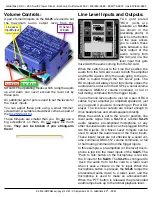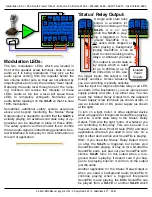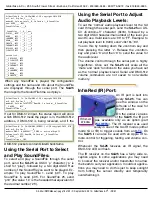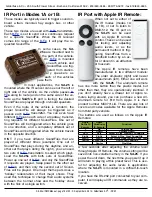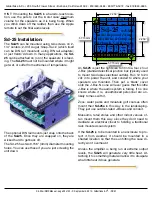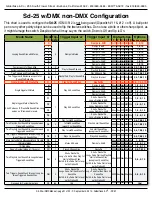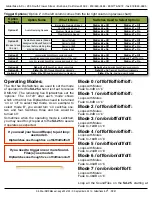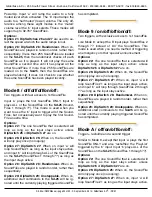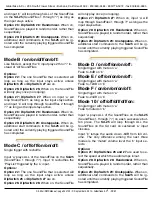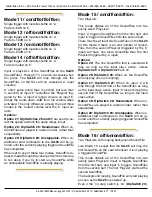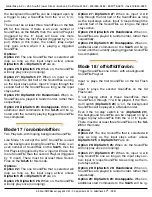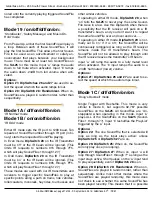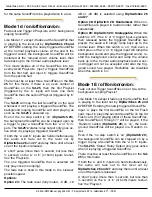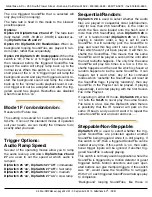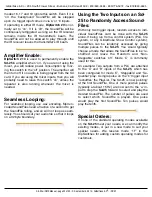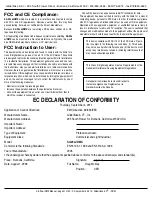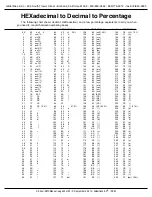
The one triggered SoundFile that is selected will
only play once (no looping).
The fade rate is fixed in this mode to the
ʻ
slowest
ʼ
possible speed.
Options:
Option #3: DipSwitches #6 and #7
. The fade level
(fully muted, -9 dB, -18 dB or -33 dB) is selected us-
ing
DipSwitches #6 and #7
.
Option #8: DipSwitch #8: Randomizer.
When on,
background looping SoundFiles are played in ran-
dom order, rather than sequentially.
Option #9: DipSwitch #9: Unsteppable.
When this
switch is
ʻ
off
ʼ
, if the
ʻ
a
ʼ
or
ʻ
b
ʼ
trigger input is pressed,
then released before the triggered SoundFile has
played, the audio will simply ramp back up to the
normal level. When this switch is
ʻ
on
ʼ
, then even a
short press of the
ʻ
a
ʼ
or
ʻ
b
ʼ
trigger input will ramp the
background sound and play the triggered sound, re-
start the background sound and ramp the volume
back up to the
ʻ
normal
ʼ
audio playback level. A sec-
ond trigger will not be accepted until after the trig-
gered sound has played. Reshuffles are disabled
when this switch is
ʻ
on
ʼ
.
Mode 1F / on/on/on/on/on:
Reserved for Future Use
This setting is reserved for
ʻ
custom
ʼ
settings on the
Sd-25s. If none of the standard modes of operation
suit your needs, we can modify the firmware to do
exactly what you need.
Trigger Options:
Audio Ramp Speed:
Several of the operating modes allow you to ramp
the audio level up and down.
DipSwitches #6 and
#7
are used to set the speed at which audio is
ramped:
DipSwitch #6
ʻ
off
ʼ
, DipSwitch #7
ʻ
off
ʼ
= immediate
DipSwitch #6
ʻ
on
ʼ
, DipSwitch #7
ʻ
off
ʼ
= fast ramp
DipSwitch #6
ʻ
off
ʼ
, DipSwitch #7
ʻ
on
ʼ
= medium
DipSwitch #6
ʻ
on
ʼ
, DipSwitch #7
ʻ
on
ʼ
= slow ramp
Sequential/Random:
DipSwitch #8
is used to select whether the audio
files are played in sequential order (alphanumeri-
cally for less than 256 SoundFiles, in the order in
which the files were loaded onto the flash card if
more than 256 SoundFiles) when
DipSwitch #8
is
ʻ
off
ʼ
, or in random order (
DipSwitch #8
ʻ
on
ʼ
). When
playing in random order, a flag is set for each
SoundFile. It will randomly pick the SoundFile to
play, and reset this flag until it runs out of Sound-
Files which haven
ʼ
t yet been played. It will then re-
shuffle the SoundFiles. This means that the same
SoundFile won
ʼ
t be played a second time until after
the next reshuffle happens. The only time the same
SoundFile will play two times in a row is if the re-
shuffle happens and the next file which is chosen at
random happens to be the same SoundFile. It can
happen, but it won
ʼ
t often. Any of the command
modes which
ʻ
reshuffle
ʼ
the SoundFiles will reset all
the SoundFile flags. If playing
ʻ
randomly
ʼ
, then any
SoundFile in the PlayList can be played. If playing
sequentially, it will start playing with the first Sound-
File in the PlayList.
If operating in either IR mode,
DipSwitch #8
, when
ʻ
on
ʼ
tells the
Sd-25
to never play the same Sound-
File twice in a row. Use this DipSwitch when there is
a possibility that the IR receiver will park on the
same IR beam, and you don
ʼ
t want it to repeat the
same SoundFile over and over and over……
Steppable/Non-Steppable:
DipSwitch #9
is used to select whether the trig-
gered SoundFiles are protected against another
SoundFile being triggered while it is still playing. If
this switch is
ʻ
off
ʼ
, then a triggered SoundFile can be
started at any time. If this switch is
ʻ
on
ʼ
, then addi-
tional trigger inputs will be ignored if another trig-
gered SoundFile is already playing.
This switch is normally used in application where the
SoundFile is triggered by a motion detector or guest
triggered button. Motion detectors and user oper-
ated buttons can give multiple triggers. If this switch
was
ʻ
off
ʼ
, would cause the SoundFile to re-trigger.
With it
ʻ
on
ʼ
each triggered SoundFile will always play
to completion.
ʻ
Background
ʼ
looping SoundFiles, like those in
Gilderfluke & Co.• 205 South Flower Street • Burbank, California 91502 • 818/840-9484 • 800/776-5972 • fax 818/840-9485
Sd-25 w/DMX Manual • page 29 of 32 • © September 4, 2014 • Gilderfluke & Co. • DCM

